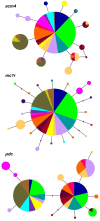Persistence across Pleistocene ice ages in Mediterranean and extra-Mediterranean refugia: phylogeographic insights from the common wall lizard
- PMID: 23841475
- PMCID: PMC3711914
- DOI: 10.1186/1471-2148-13-147
Persistence across Pleistocene ice ages in Mediterranean and extra-Mediterranean refugia: phylogeographic insights from the common wall lizard
Abstract
Background: Pleistocene climatic oscillations have played a major role in structuring present-day biodiversity. The southern Mediterranean peninsulas have long been recognized as major glacial refugia, from where Northern Europe was post-glacially colonized. However, recent studies have unravelled numerous additional refugia also in northern regions. We investigated the phylogeographic pattern of the widespread Western Palaearctic lizard Podarcis muralis, using a range-wide multilocus approach, to evaluate whether it is concordant with a recent expansion from southern glacial refugia or alternatively from a combination of Mediterranean and northern refugia.
Results: We analyzed DNA sequences of two mitochondrial (cytb and nd4) and three nuclear (acm4, mc1r, and pdc) gene fragments in individuals from 52 localities across the species range, using phylogenetic and phylogeographic methods. The complex phylogeographic pattern observed, with 23 reciprocally monophyletic allo- parapatric lineages having a Pleistocene divergence, suggests a scenario of long-term isolation in multiple ice-age refugia across the species distribution range. Multiple lineages were identified within the three Mediterranean peninsulas - Iberia, Italy and the Balkans - where the highest genetic diversity was observed. Such an unprecedented phylogeographic pattern - here called "refugia within all refugia" - compasses the classical scenario of multiple southern refugia. However, unlike the southern refugia model, various distinct lineages were also found in northern regions, suggesting that additional refugia in France, Northern Italy, Eastern Alps and Central Balkans allowed the long-term persistence of this species throughout Pleistocene glaciations.
Conclusions: The phylogeography of Podarcis muralis provides a paradigm of temperate species survival in Mediterranean and extra-Mediterranean glacial refugia. Such refugia acted as independent biogeographic compartments for the long-term persistence of this species, for the differentiation of its genetic lineages, and for the short-distance post-glacial re-colonization of neighbouring areas. This finding echoes previous findings from recent phylogeographic studies on species from temperate ecoregions, thus suggesting the need for a reappraisal of the role of northern refugia for glacial persistence and post-glacial assembly of Holarctic biota.
Figures


Similar articles
-
A combination of long term fragmentation and glacial persistence drove the evolutionary history of the Italian wall lizard Podarcis siculus.BMC Evol Biol. 2017 Jan 5;17(1):6. doi: 10.1186/s12862-016-0847-1. BMC Evol Biol. 2017. PMID: 28056768 Free PMC article.
-
Phylogeography and historical demography of the Lusitanian snail Elona quimperiana reveal survival in unexpected separate glacial refugia.BMC Evol Biol. 2008 Dec 19;8:339. doi: 10.1186/1471-2148-8-339. BMC Evol Biol. 2008. PMID: 19099565 Free PMC article.
-
Digging up the roots of an insular hotspot of genetic diversity: decoupled mito-nuclear histories in the evolution of the Corsican-Sardinian endemic lizard Podarcis tiliguerta.BMC Evol Biol. 2017 Mar 2;17(1):63. doi: 10.1186/s12862-017-0899-x. BMC Evol Biol. 2017. PMID: 28253846 Free PMC article.
-
Plant molecular phylogeography in China and adjacent regions: Tracing the genetic imprints of Quaternary climate and environmental change in the world's most diverse temperate flora.Mol Phylogenet Evol. 2011 Apr;59(1):225-44. doi: 10.1016/j.ympev.2011.01.012. Epub 2011 Feb 1. Mol Phylogenet Evol. 2011. PMID: 21292014 Review.
-
Evaluating signatures of glacial refugia for North Atlantic benthic marine taxa.Ecology. 2008 Nov;89(11 Suppl):S108-22. doi: 10.1890/08-0257.1. Ecology. 2008. PMID: 19097488 Review.
Cited by
-
Persistence and dispersal in a Southern Hemisphere glaciated landscape: the phylogeography of the spotted snow skink (Niveoscincus ocellatus) in Tasmania.BMC Evol Biol. 2015 Jun 26;15:121. doi: 10.1186/s12862-015-0397-y. BMC Evol Biol. 2015. PMID: 26111715 Free PMC article.
-
Inter- and intra-population variability of the protein content of femoral gland secretions from a lacertid lizard.Curr Zool. 2017 Dec;63(6):657-665. doi: 10.1093/cz/zow113. Epub 2016 Dec 26. Curr Zool. 2017. PMID: 29492027 Free PMC article.
-
A combination of long term fragmentation and glacial persistence drove the evolutionary history of the Italian wall lizard Podarcis siculus.BMC Evol Biol. 2017 Jan 5;17(1):6. doi: 10.1186/s12862-016-0847-1. BMC Evol Biol. 2017. PMID: 28056768 Free PMC article.
-
Microevolution of the noble crayfish (Astacus astacus) in the Southern Balkan Peninsula.BMC Evol Biol. 2017 May 30;17(1):122. doi: 10.1186/s12862-017-0971-6. BMC Evol Biol. 2017. PMID: 28558646 Free PMC article.
-
Biogeographic and demographic history of the Mediterranean snakes Malpolon monspessulanus and Hemorrhois hippocrepis across the Strait of Gibraltar.BMC Ecol Evol. 2021 Nov 22;21(1):210. doi: 10.1186/s12862-021-01941-3. BMC Ecol Evol. 2021. PMID: 34809580 Free PMC article.
References
-
- Hewitt GM. Some genetic consequences of ice ages and their role in divergence and speciation. Biol J Linn Soc Lond. 1996;58:247–276.
Publication types
MeSH terms
LinkOut - more resources
Full Text Sources
Other Literature Sources

